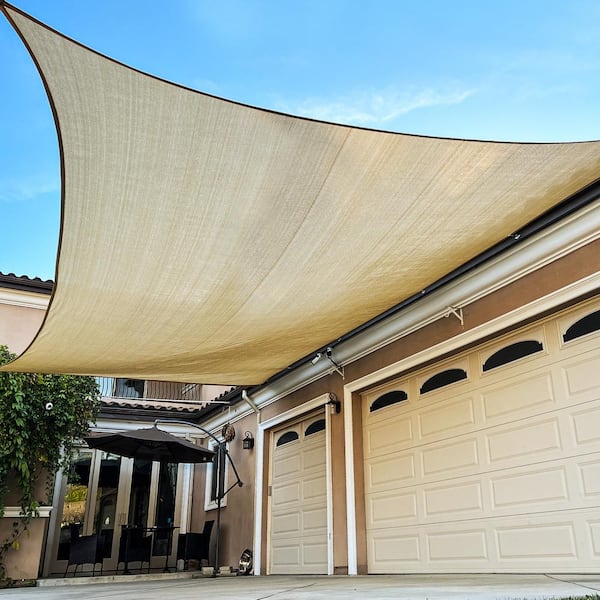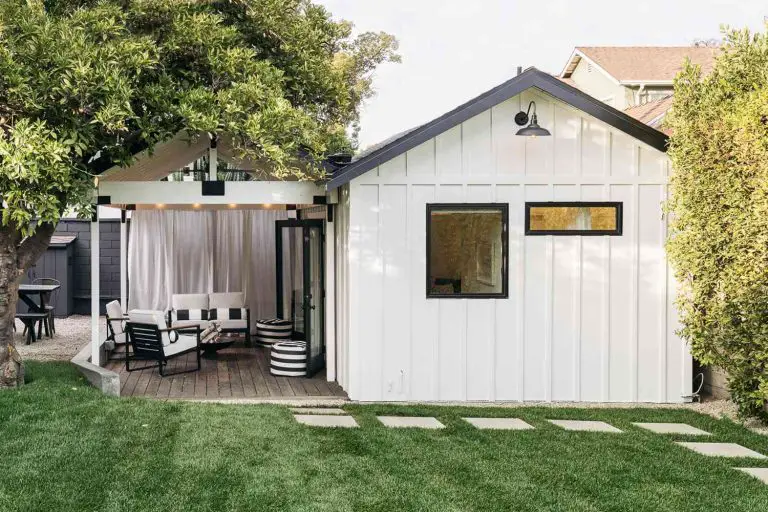Looking to block wind on your patio and deck? Check out these 6 effective ways to keep the wind out and create a comfortable outdoor space.
From installing wind screens and using outdoor curtains to setting up a windbreak wall or adding a pergola with a retractable canopy, these options provide practical solutions for enjoying your patio and deck without the hassle of wind disturbance.

Credit: www.homedepot.com
Creating Windbreaks
When it comes to enjoying your patio or deck on a windy day, creating windbreaks can make all the difference. These structures serve as barriers to block the wind, allowing you to relax and entertain outdoors without the constant gusts disturbing your peace.
Here are three effective ways to create windbreaks for your patio or deck:
Installing Pergolas Or Awnings For Wind Protection:
- Pergolas and awnings provide excellent wind protection while adding a touch of elegance to your outdoor space.
- They can be customized to fit your patio or deck’s dimensions, ensuring maximum coverage and wind barrier.
- The strong and sturdy structure of pergolas and awnings can withstand even the strongest winds, making them a reliable choice.
Using Outdoor Curtains Or Shades To Block Wind:
- Outdoor curtains and shades are versatile options for blocking wind and providing privacy.
- Opt for heavy-duty outdoor curtains or shades made from durable materials that can withstand various weather conditions.
- These can be installed on a track system, allowing you to easily adjust them based on the wind direction and intensity.
Incorporating Privacy Screens Or Fences For Wind Deflection:
- Privacy screens and fences not only offer privacy but also help deflect wind away from your patio or deck.
- Choose solid privacy screens or fences that are tall enough to create a barrier against the wind.
- You can also consider decorative options such as lattice screens or slatted fences, which still provide some wind protection while allowing airflow.
By incorporating one or more of these windbreak options, you can create a more enjoyable outdoor space free from strong winds. Experiment with different combinations to find the ideal solution for your patio or deck, and make the most of your outdoor living area regardless of the weather conditions.
Utilizing Natural Barriers
When it comes to blocking wind on your patio or deck, utilizing natural barriers can be an effective and aesthetically pleasing solution. By strategically planting trees or shrubs, and using hedges or bushes as windbreaks, you can create a more comfortable outdoor space.
Here are some key points to consider when utilizing natural barriers:
- Planting trees or shrubs strategically to block wind:
Planting trees or shrubs strategically around your patio or deck can help block the wind and create a more sheltered environment. Consider the following tips:
- Choose trees or shrubs that are known for their wind-blocking properties, such as evergreens or thick-leaved varieties.
- Place taller trees or shrubs on the windward side of your patio or deck to act as a buffer against strong winds.
- Ensure there is enough space between the trees or shrubs to allow for airflow while still providing wind protection.
- Using hedges or bushes as windbreaks:
Hedges or bushes can also be used effectively as windbreaks on your patio or deck. Here are some considerations:
- Opt for dense and sturdy hedge varieties, such as boxwood or yew, that can withstand strong winds.
- Plant the hedge in a straight line parallel to your patio or deck to create a solid barrier against the wind.
- Trim and maintain the hedge regularly to ensure its effectiveness as a windbreak.
- Optimal placement and selection of natural barriers for maximum effectiveness:
To maximize the effectiveness of natural barriers, keep the following in mind:
- Study the wind patterns in your area to identify the most prevalent wind direction.
- Position your natural barriers on the windward side of your patio or deck to intercept the wind before it reaches your outdoor space.
- Consider the height and density of the natural barriers to ensure they effectively block the wind.
Remember, the key to utilizing natural barriers successfully is proper planning and maintenance. By carefully selecting the right trees, shrubs, and hedges, and positioning them strategically, you can create a wind-free zone on your patio or deck.
Installing Wind Mesh Or Screens
Installing wind mesh or screens is an effective way to block wind on your patio and deck, providing a more comfortable outdoor experience. Not only do wind mesh or screens create a barrier against strong gusts, but they also help to maintain privacy and protect against dust and debris.
Let’s explore the benefits of using wind mesh or screens, the different types available, and proper installation techniques and considerations.
Benefits Of Wind Mesh Or Screens For Blocking Wind:
- Wind reduction: Wind mesh or screens act as a windbreak, reducing the intensity of strong gusts and creating a more enjoyable outdoor environment.
- Privacy: Installing wind mesh or screens can help to create a secluded space, shielding your patio or deck from prying eyes.
- Dust and debris protection: These mesh or screens significantly reduce the amount of airborne particles, such as dust and debris, from entering your outdoor space, ensuring a cleaner area.
- Energy efficiency: By blocking wind, wind mesh or screens can also contribute to energy savings by reducing heat loss and minimizing the need for additional heating on cool days.
- Versatility: Wind mesh or screens are available in various styles and colors, allowing you to choose the one that best complements your outdoor decor.
Different Types Of Wind Mesh Or Screens Available:
- Fabric mesh: Made from durable materials like polyethylene, fabric mesh is commonly used for blocking wind on patios and decks. It comes in different densities, allowing you to choose the level of wind protection you desire.
- Pvc screens: Pvc screens offer a more rigid and durable option. They are highly resistant to weather conditions and often come with uv protection to prevent fading and degradation over time.
- Roll-up screens: These screens can be easily rolled up or down, depending on the weather conditions. They provide flexibility and convenience, allowing you to adjust the level of wind blockage as needed.
Proper Installation Techniques And Considerations:
- Measurements: Before installing wind mesh or screens, accurately measure the dimensions of your patio or deck to ensure you purchase the right size.
- Secure fastening: It’s essential to properly secure the wind mesh or screens to prevent them from getting dislodged during strong winds. Choose sturdy fasteners that are suitable for the surface you’re installing on, such as screws for wood or concrete anchors for masonry.
- Tensioning: Apply appropriate tension to the wind mesh or screens to prevent sagging or billowing. This will ensure optimal wind resistance and longevity.
- Maintenance: Regularly clean and maintain your wind mesh or screens to keep them in good condition. Remove any accumulated debris or dirt, and check for any signs of damage that may require repairs or replacement.
With wind mesh or screens installed on your patio or deck, you can create a tranquil and protected outdoor space that allows you to enjoy the fresh air without the discomfort of strong winds. Take the time to choose the right type of wind mesh or screen, carefully install it, and reap the benefits of a wind-free oasis right outside your door.
Building Windproof Structures
Building windproof structures is an essential step in creating a comfortable and enjoyable outdoor space on your patio or deck. Whether you’re looking to block strong gusts or create a cozy nook shielded from the elements, there are several ways to achieve wind protection.
In this section, we will explore two effective methods: constructing windproof walls or barriers and designing open-air structures with built-in wind protection.
Constructing Windproof Walls Or Barriers
Windproof walls or barriers act as physical shields against the wind, providing a solid and stable structure that reduces the impact of gusts. Here are the key points to consider when constructing windproof walls or barriers:
- Choose sturdy materials: Opt for durable materials such as brick, stone, or wood with proper reinforcements to withstand wind pressure.
- Pay attention to height and width: Determine the appropriate height and width of the walls or barriers based on the wind patterns in your area. Higher walls are generally more effective in blocking strong winds.
- Consider windbreak plantings: Planting wind-resistant trees, shrubs, or hedges near the walls or barriers can further enhance their effectiveness by creating an additional buffer zone.
Designing Open-Air Structures With Built-In Wind Protection
Another approach to block wind on your patio or deck is to design open-air structures that integrate wind protection features. Here are some essential aspects to incorporate when designing such structures:
- Optimal placement: Position the structure strategically, taking into account the predominant wind direction and the layout of your outdoor space. This will help maximize wind resistance and minimize the impact of gusts.
- Lattice or slatted panels: Utilize lattice or slatted panels on one or more sides of the structure to create a partially enclosed area. These panels allow for airflow while reducing the strength of the wind.
- Adjustable wind screens: Install adjustable wind screens that can be raised or lowered as needed. These screens provide flexibility in controlling wind exposure and can be repositioned according to changing weather conditions.
By implementing these methods, you can effectively block wind on your patio or deck, providing a more comfortable and enjoyable outdoor experience. Whether you choose to construct windproof walls or barriers or design open-air structures with built-in wind protection, your outdoor space will be transformed into a serene oasis shielded from the blustery elements.
So, go ahead and make your patio or deck a windproof paradise!
Utilizing Windproof Furniture And Accessories
Selecting Windproof Furniture For Patio And Deck Spaces
When it comes to patio and deck spaces, selecting the right furniture that can withstand strong winds is essential. Here are the key points to consider:
- Choose heavy furniture: Opt for sturdy materials like wrought iron, teak, or cast aluminum that can withstand gusty winds.
- Look for low-profile designs: Furniture with a lower center of gravity is less likely to be toppled over by strong winds.
- Consider wind-resistant features: Look for furniture with built-in wind resistance features such as wind vents in patio umbrellas or mesh panels on chairs.
- Avoid lightweight materials: Stay away from furniture made from lightweight materials like plastic or lightweight aluminum, as these are more prone to wind damage.
- Opt for compact and foldable options: If you live in an area with high wind conditions, consider furniture that can be easily folded and stored away during strong winds.
- Check for stability: Ensure that the furniture has stable bases or legs that can be securely anchored to the ground or deck.
Incorporating Wind-Resistant Accessories Such As Weighted Tablecloths
In addition to windproof furniture, incorporating wind-resistant accessories can further enhance your patio and deck’s wind-blocking capabilities. Consider the following key points:
- Weighted tablecloths: Use tablecloths with weights or clips designed to keep them in place, preventing them from blowing away in the wind.
- Windproof curtains or screens: Install outdoor curtains or screens to create a windbreak, reducing the wind’s impact on your patio or deck area.
- Windproof blinds or shades: Install blinds or shades that are wind-resistant to provide additional protection from strong gusts.
- Wind chimes or wind spinners: Hang wind chimes or wind spinners in your patio or deck area to alert you to incoming wind and to help break up the airflow.
- Outdoor rugs with anchor stakes: Invest in outdoor rugs that come with anchor stakes, securing them to the ground and preventing them from being blown away.
- Windproof planters: Opt for heavy or weighted planters to ensure your plants stay in place during windy conditions.
Tips For Anchoring And Securing Outdoor Items Against Strong Winds
While windproof furniture and accessories can help, it’s crucial to properly anchor and secure your outdoor items to ensure they stay in place during strong winds. Here are some key tips to consider:
- Use anchor bolts or straps: Secure large items, such as umbrellas, pergolas, or canopies, by using anchor bolts or straps to firmly attach them to the ground or deck.
- Secure smaller items: Use heavy-duty hooks or straps to secure smaller items, such as cushions, pillows, or lightweight furniture, to prevent them from blowing away.
- Invest in wind-resistant fasteners: Replace standard screws and nails with wind-resistant fasteners designed to withstand strong winds.
- Store loose items indoors: During severe weather conditions, bring in any loose items such as cushions, decorations, or outdoor toys to prevent them from becoming projectiles.
- Regularly inspect and maintain anchors: Check periodically for loose or damaged anchors and promptly repair or replace them as needed.
With these tips, you can create a patio or deck space that will effectively block wind and enhance your outdoor living experience. Remember to choose windproof furniture, incorporate wind-resistant accessories, and properly anchor and secure your outdoor items against strong winds.
Conclusion
To create an inviting and comfortable outdoor space on your patio or deck, blocking wind is crucial. Thankfully, there are several effective solutions to help you achieve this. Installing outdoor curtains is a simple yet effective way to block wind while adding privacy and style to your outdoor area.
Alternatively, using a windbreak fence or privacy screens can provide excellent protection from strong gusts of wind. If you prefer a more natural approach, planting tall shrubs or trees strategically around your patio or deck can help create a natural windbreak.
Another option is to invest in a retractable awning, which not only blocks wind but also provides shade and protection from the sun. Lastly, utilizing outdoor furniture with built-in wind protection, like high-backed chairs and sectional sofas, can make your outdoor space more enjoyable on windy days.
With these six solutions in mind, you can now create a wind-free oasis that you and your loved ones can enjoy year-round.






